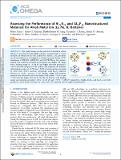Files in this item
Assessing the performance of Al12N12 and Al12P12 nanostructured materials for alkali metal ion (Li, Na, K) batteries
Item metadata
| dc.contributor.author | Louis, Hitler | |
| dc.contributor.author | Ekereke, Ernest E. | |
| dc.contributor.author | Isang, Bartholomew B. | |
| dc.contributor.author | Ikeuba, Alexander I. | |
| dc.contributor.author | Amodu, Ismail O. | |
| dc.contributor.author | Gber, Terkumbur E. | |
| dc.contributor.author | Owen, Aniekan E. | |
| dc.contributor.author | Adeyinka, Adedapo S. | |
| dc.contributor.author | Agwamba, Ernest C. | |
| dc.date.accessioned | 2022-12-08T13:30:02Z | |
| dc.date.available | 2022-12-08T13:30:02Z | |
| dc.date.issued | 2022-12-20 | |
| dc.identifier | 282491256 | |
| dc.identifier | 1241e238-81fe-469c-9ac1-7c3c655b404b | |
| dc.identifier | 85143859445 | |
| dc.identifier | 000894120700001 | |
| dc.identifier.citation | Louis , H , Ekereke , E E , Isang , B B , Ikeuba , A I , Amodu , I O , Gber , T E , Owen , A E , Adeyinka , A S & Agwamba , E C 2022 , ' Assessing the performance of Al 12 N 12 and Al 12 P 12 nanostructured materials for alkali metal ion (Li, Na, K) batteries ' , ACS Omega , vol. 7 , no. 50 , pp. 46183–46202 . https://doi.org/10.1021/acsomega.2c04319 | en |
| dc.identifier.issn | 2470-1343 | |
| dc.identifier.other | RIS: urn:8C6BB53C4B0AA683C220977D366414EC | |
| dc.identifier.uri | https://hdl.handle.net/10023/26560 | |
| dc.description.abstract | This study focused on the potential of aluminum nitride (Al12N12) and aluminum phosphide (Al12P12) nanomaterials as anode electrodes of lithium-ion (Li-ion), sodium-ion (Na-ion), and potassium-ion (K-ion) batteries as investigated via density functional theory (DFT) calculations at PBE0-D3, M062X-D3, and DSDPBEP86 as the reference method. The results show that the Li-ion battery has a higher cell voltage with a binding energy of −1.210 eV and higher reduction potential of −6.791 kcal/mol compared to the sodium and potassium ion batteries with binding energies of −0.749 and −0.935 eV and reduction potentials of −6.414 and −6.513 kcal/mol, respectively, using Al12N12 material. However, in Al12P12, increases in the binding energy and reduction potential were observed in the K-ion battery with values −1.485 eV and −7.535 kcal/mol higher than the Li and Na ion batteries with binding energy and reduction potential −1.483, −1.311 eV and −7.071, −7.184 eV, respectively. Finally, Al12N12 and Al12P12 were both proposed as novel anode electrodes in Li-ion and K-ion batteries with the highest performances. | |
| dc.format.extent | 20 | |
| dc.format.extent | 14972809 | |
| dc.language.iso | eng | |
| dc.relation.ispartof | ACS Omega | en |
| dc.subject | QD Chemistry | en |
| dc.subject | NDAS | en |
| dc.subject | NIS | en |
| dc.subject | MCC | en |
| dc.subject.lcc | QD | en |
| dc.title | Assessing the performance of Al12N12 and Al12P12 nanostructured materials for alkali metal ion (Li, Na, K) batteries | en |
| dc.type | Journal article | en |
| dc.contributor.institution | University of St Andrews. School of Chemistry | en |
| dc.identifier.doi | https://doi.org/10.1021/acsomega.2c04319 | |
| dc.description.status | Peer reviewed | en |
This item appears in the following Collection(s)
Items in the St Andrews Research Repository are protected by copyright, with all rights reserved, unless otherwise indicated.

